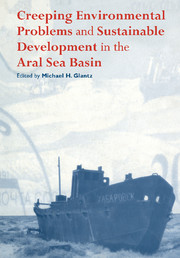Book contents
- Frontmatter
- Contents
- List of contributors
- Introduction
- 1 Sustainable development and creeping environmental problems in the Aral Sea region
- 2 Ecological disaster linked to landscape composition changes in the Aral Sea basin
- 3 Alteration of water level and salinity of the Aral Sea
- 4 Desertification in the Aral Sea region
- 5 Climate fluctuations and change in the Aral Sea basin within the last 50 years
- 6 Priaralye ecosystems and creeping environmental changes in the Aral Sea
- 7 Public health in the Aral Sea coastal region and the dynamics of changes in the ecological situation
- 8 The impact of political ideology on creeping environmental changes in the Aral Sea basin
- 9 Change of the rivers' flow in the Aral Sea basin (in connection with the problem of quantitative assessment and consideration of environmental after-effects)
- 10 Fish population as an ecosystem component and economic object in the Aral Sea basin
- 11 Creeping environmental changes in the Karakum Canal's zone of impact
- 12 Environmental changes in the Uzbek part of the Aral Sea basin
- 13 Creeping changes in biological communities in the Aral Sea
- Index
9 - Change of the rivers' flow in the Aral Sea basin (in connection with the problem of quantitative assessment and consideration of environmental after-effects)
Published online by Cambridge University Press: 19 October 2009
- Frontmatter
- Contents
- List of contributors
- Introduction
- 1 Sustainable development and creeping environmental problems in the Aral Sea region
- 2 Ecological disaster linked to landscape composition changes in the Aral Sea basin
- 3 Alteration of water level and salinity of the Aral Sea
- 4 Desertification in the Aral Sea region
- 5 Climate fluctuations and change in the Aral Sea basin within the last 50 years
- 6 Priaralye ecosystems and creeping environmental changes in the Aral Sea
- 7 Public health in the Aral Sea coastal region and the dynamics of changes in the ecological situation
- 8 The impact of political ideology on creeping environmental changes in the Aral Sea basin
- 9 Change of the rivers' flow in the Aral Sea basin (in connection with the problem of quantitative assessment and consideration of environmental after-effects)
- 10 Fish population as an ecosystem component and economic object in the Aral Sea basin
- 11 Creeping environmental changes in the Karakum Canal's zone of impact
- 12 Environmental changes in the Uzbek part of the Aral Sea basin
- 13 Creeping changes in biological communities in the Aral Sea
- Index
Summary
The environmental disaster in the Aral Sea basin is a direct result of societal overuse of the water resources of the basin's two major rivers, the Amudarya and the Syrdarya. Societal activities are responsible for serious reductions in both the quantity and the quality of river flow and for negative impacts on the major components of the region's ecosystems which are directly dependent on the availability of surface water. Thus, an assessment of the region's water resources, including changes in their use, is necessary to identify the impact of anthropogenic factors on river flow and to identify hydrological measures that could improve environmental conditions in the basin.
The Aral basin lies in the heart of the Eurasian landmass, far from the direct influences of the oceans. It therefore has a continental climate (i.e., marked seasonality) and an abundance of warm and sunny days. The major part of the basin is covered by the Turan Lowland deserts bordering on the Tien Shan and Pamir-Alai mountains. Glaciers and snowfields are the main sources of water feeding the region's two major rivers – the Amudarya with a catchment area of 1.1 million km2, and the Syrdarya with a catchment area of 0.44 million km2. Unlike the mountainous part of the basin, which is the zone of formation of river flow, the lowlying flat land is a zone where water resources are dissipated as a result of evaporation from both irrigated and natural areas (Shults, 1965).
Irrigation farming ever since the distant past has been the main economic activity in the Aral Sea basin.
- Type
- Chapter
- Information
- Publisher: Cambridge University PressPrint publication year: 1999
- 1
- Cited by



